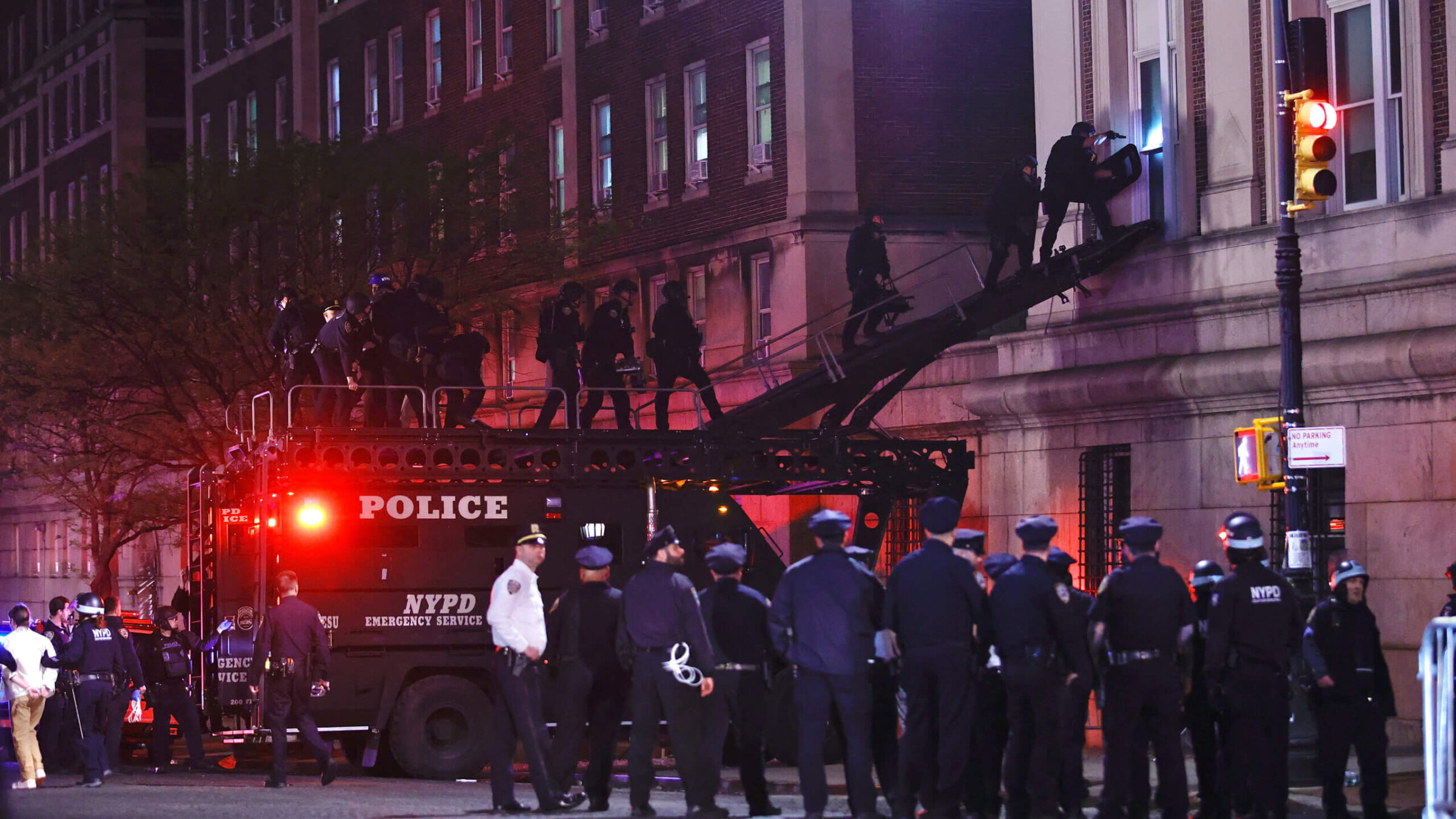Columbia squandered ample opportunities to chart a path without involving police
The university had abundant resources to protect students and foster dialogue on campus, and failed.

NYPD officers in riot gear break into Hamilton Hall at Columbia University, where pro-Palestinian students barricaded themselves inside a building, April 30, 2024. Photo by Kena Betancur/AFP via Getty Images
In the coming days and weeks, there will be many analyses of what went wrong on Columbia University’s campus this spring. And as an alumna who has been watching the campus from afar for the past seven months, I am mourning the alternate version of what could have unfolded there — not just on the night of April 30, when hundreds of New York Police Department officers descended on campus to forcibly evict protesters who had seized Hamilton Hall — but throughout the preceding months.
The administration repeatedly and aggressively failed to make choices that could have not just kept students safe, but fostered an environment that could have served as a positive inspiration for the rest of the country.
When I arrived on the Columbia campus as an undergraduate in fall 1999, the school was still emerging from the shadows of a decades-old tragedy. Whenever US New & World Report would release its annual rankings of American universities, Columbia would inevitably be docked for its low rate of alumni giving — a legacy, I’d heard, of the still vibrant anger many former Columbia students felt over the administration’s botched handling of the 1968 student protests, which ended in violence.
Yet by the late 1990s, that was all supposed to be a distant memory. Columbia, students were told, was proud of its legacy as an incubator for young activists, even if it didn’t always have the warmest reception for contemporary student protesters. Alum Emma Sulkowicz, who famously carried a mattress around campus for an entire year, including on stage at commencement, in protest of Columbia’s policies on student sexual assault, was snubbed at her graduation by then-president Lee Bollinger, who refused to shake her hand after she received her diploma.
But even if Columbia wasn’t always appreciative of student activists, it still seemed as though the violent days of calling in the police to suppress and evict protesters were a distant memory. Until, tragically, this spring: first on April 18, when the NYPD was called in to clear pro-Palestinian protesters from their lawn encampment, and again this week when a smaller group of protesters seized Hamilton Hall and the NYPD was brought in to evict and arrest them, in an eerie echo of 1968.
From the beginning of the Israel-Gaza conflict, Columbia was in a unique position to encourage a respectful, productive dialogue. In addition to being home to a sizable population of Jewish students — according to Hillel, 22.5% of undergrads and 15.5% of graduate students at Columbia are Jewish — Columbia was the longtime employer of the noted Palestinian academic Edward Said, and boasts its very own Center for Palestine Studies. It is not hard to imagine a universe in which Columbia took the path of its fellow Ivy, Dartmouth, which opted to confront tensions over the war in Israel and Palestine with a series of forums featuring faculty experts on the Middle East.
Such a strategy might have given the understandably traumatized and angry Columbia student body a constructive venue for discussion and debate; a place to learn about the painful history of both Israelis and Palestinians while processing the violence of both Oct. 7 and the subsequent assault on Gaza in a way that honored the pain and trauma of both peoples. But that strategy, unfortunately, was never employed.
Instead, tensions began to rapidly rise on campus. To some, the school became emblematic of American universities’ antisemitism problem — the “Columbia Untisemity” parodied in Israel’s long-running sketch comedy show Eretz Nehaderet, which depicted two naive, pierced and tattooed leftists buddying up with a Hamas militant who clearly sees them as useful idiots. For others, it was obvious that Columbia was abandoning its duty to protect pro-Palestinian protesters, who faced doxxing and harassment — most notably from Israeli business school professor Shai Davidai, who has made no secret of his disdain for student support for Palestine.
By the time Columbia President Minouche Shafik authorized the NYPD to clear the Gaza Solidarity Encampment that had taken over Columbia’s South Lawn, it was clear that the protesters and the administration were approaching an impasse. Columbia had never seemed likely to accept the demands of Columbia University Apartheid Divest, which included full divestment from a range of companies with loose ties to Israel and the abandonment of Columbia’s Tel Aviv Global Center. And as the university continued to treat student protesters not as impassioned activists motivated by justice, but as a public nuisance creating a quality of life issue on campus, it seemed clear that things could only go from bad to worse.
And yet. Even in the aftermath of the first round of arrests on April 18, I still found myself holding out hope that the administration would see the error of its ways and find a different path. In emails to alumni, the administration declared that it had turned away from calls for the police and toward negotiation. “The University is in active dialogue with leaders of ongoing campus demonstrations to find a resolution that avoids further escalation while allowing central University functions to continue. To that end, the University is taking steps to de-escalate tensions and reset as next steps are formulated,” Josef Sorett, dean of Columbia College, wrote in an email to alumni on April 24.
A few hundred miles away in Providence, Rhode Island, Brown administrators had also made their fair share of missteps. Protesters were arrested twice in the fall and winter; hunger strikes by students who wanted divestment went ignored. But when Brown students set up their own encampment, the administration reacted, not with suppression, but by allowing the encampments to remain and keeping the campus open to the public as negotiations commenced.
The same day that Columbia students seized Hamilton Hall, their peers at Brown University were dismantling their encampment after their own administration agreed to give their demands for divestment a fair hearing. That, too, could have been Columbia, if only the school’s leadership had remembered the painful lessons of the past.
Unfortunately, what unfolded instead was an echo of some of Columbia’s bleakest history. Whatever one thinks of the demands of the student protesters, their treatment can only be considered a tragedy. The sight of NYPD officers storming Hamilton Hall and loading student protesters onto a bus was heartbreaking enough. But the fact that the administration has doubled down by inviting police to stay on campus throughout commencement is what truly turns my stomach.
At a time when students are supposed to be finishing up exams and joyously celebrating their commencement, their campus has been militarized in an attempt to crack down on free expression. That is not the Columbia that I love — and it is a Columbia that I would have a difficult time recommending that any passionate young student consider applying to.
I can only hope that Columbia will emerge from this fiasco newly chastened and recommitted to the lessons it claimed to have learned decades ago: Student protesters cannot be defeated through violence. They must be protected, supported and — most important of all — respectfully engaged through the very constructive dialogue that liberal academic institutions like Columbia are supposed to stand for in the first place.
A message from our Publisher & CEO Rachel Fishman Feddersen

I hope you appreciated this article. Before you go, I’d like to ask you to please support the Forward’s award-winning, nonprofit journalism so that we can be prepared for whatever news 2025 brings.
At a time when other newsrooms are closing or cutting back, the Forward has removed its paywall and invested additional resources to report on the ground from Israel and around the U.S. on the impact of the war, rising antisemitism and polarized discourse.
Readers like you make it all possible. Support our work by becoming a Forward Member and connect with our journalism and your community.
— Rachel Fishman Feddersen, Publisher and CEO




























